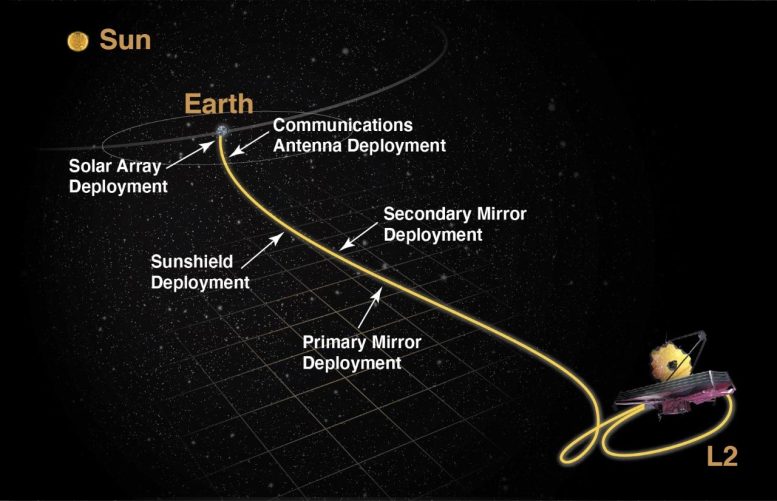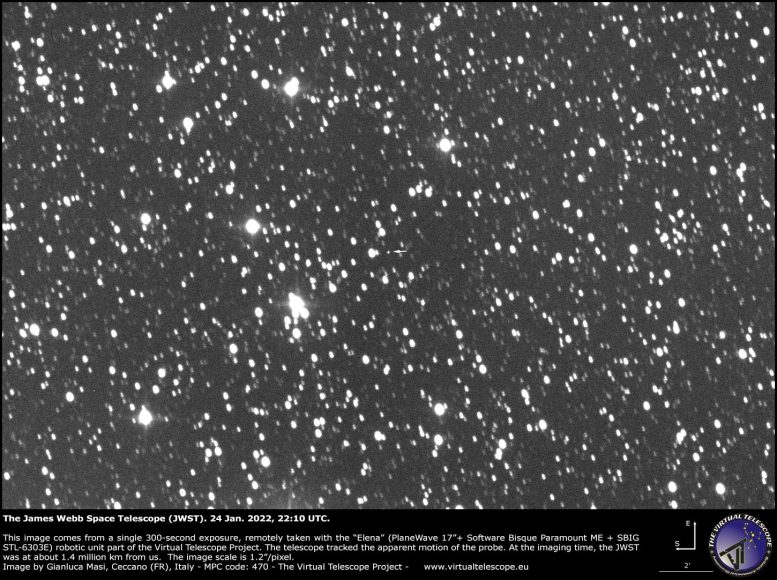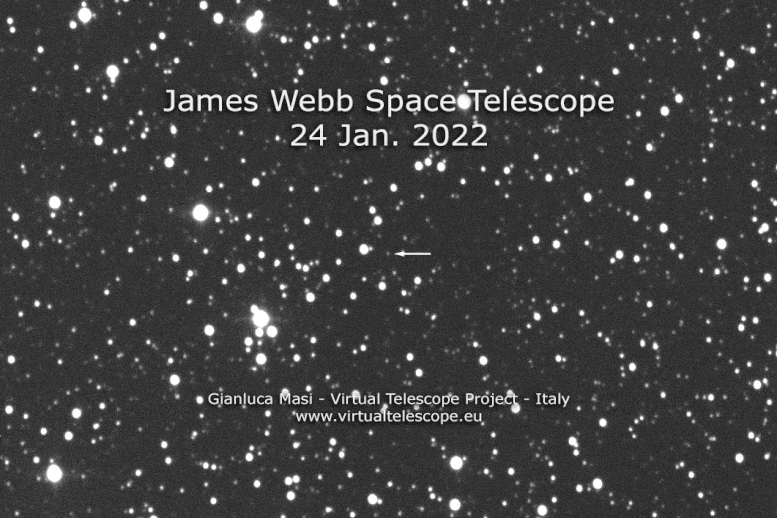Science
What NASA's James Webb Looks Like From Powerful Earth Telescopes – SciTechDaily
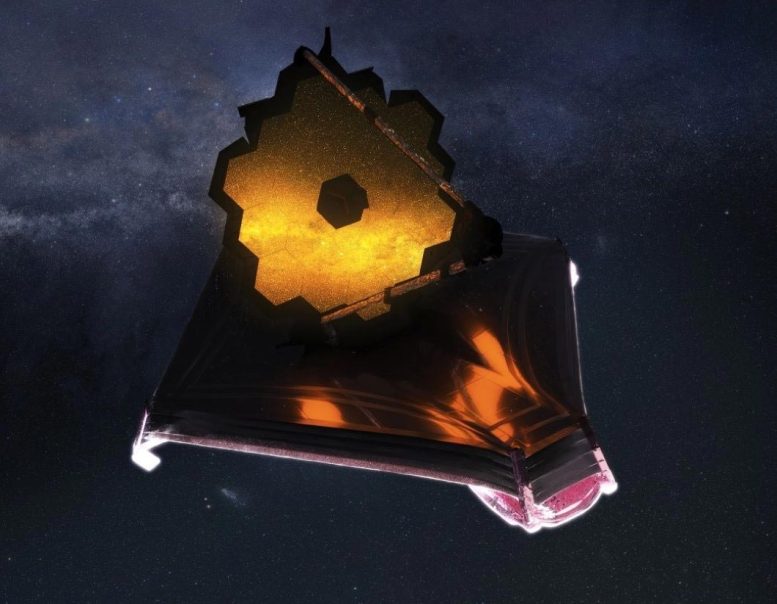
This artist’s conception shows the fully unfolded James Webb Space Telescope in space. Credit: Adriana Manrique Gutierrez, NASA Animator
The past month has been an exciting time for the James Webb Space Telescope! After launching on Christmas Day, the telescope spent the next few weeks deploying its mirrors, checking the individual segments, and then maneuvering to L2, where it will spend the next ten to twenty years unlocking the mysteries of the cosmos. According to NASA Administrator Bill Nelson and the Chief Science Communications Officer (CSCO) for the JWST, James Webb will begin collecting light this summer.
To mark the occasion, the Virtual Telescope Project (VTP) captured images of James Webb to give people a sense of what it looks like in orbit. Unfortunately, there’s not a lot to see there, other than a bright dot in the night sky. But like Carl Sagan’s famous “Pale Blue Dot” picture of Earth (taken by Voyager 1 on its way out of the Solar System), or Cassini’s “The Day Earth Smiled” image, there’s a tremendous amount of significance in that small point of light.
The VTP is an advanced astronomical service launched in 2006 by the Bellatrix Astronomical Observatory, located in Ceccano, Italy. The VTP operates two remotely-accessible robotic telescopes, the Planewave 17-inch g/6.8 (432/2939 mm) Corrected Dall-Kirkham Astrograph (aka. “Elena”), and the Celestron 14″-f/8.4 (356/3000 mm) Schmidt-Cassegrain OTA. They also offer public online observing sessions, live streams, expert commentary from their scientific staff, and public outreach to people worldwide.
The image of the JWST (shown below) was taken on January 24th using Elena. This robotic telescope tracked the apparent motion of the JWST automatically and acquired a single 300-single unfiltered exposure that shows the telescope’s position (indicated by an arrow in the center). When it was imaged, the JWST had reached its final destination (L2), placing it at a distance of about 1.4 million km (869,920 mi) from Earth.
In addition to the above image, the VTP also created a short GIF animation (below) that shows the JWST’s apparent motion against the stars. While it may look like little more than a tiny dot against a background of brighter dots (and the darkness of space), these images tell a story of an ambitious mission that was decades in the making. Work began on the telescope in 1996, and it was initially hoped that the James Webb would be launched by 2007 and with a budget of $500 million.
Unfortunately, there were many delays and cost overruns due to a major redesign, issues with the sunshield, and the Ariane 5 rocket that would launch it. The COVID-19 pandemic also imposed delays, as did the fact that the James Webb is the most complex and advanced space telescope ever conceived. Time and again, the origami-like nature of the telescope (where it has to fold up to fit within a payload fairing) required extensive testing runs, and the slightest issues required retesting and safety checks.
By 2016, construction was finally finished, but an extensive testing program still had to be completed. By late 2021, the telescope testing finished up, and the James Webb was shipped to Kourou, French Guiana, for integration with the Ariane 5 rocket. When the launch finally happened on Christmas Day, it went off without a hitch. Thomas Zurbuchen, NASA’s associate administrator for science missions, commented, “It’s truly Christmas with all the presents and everything and we have a space mission!”
By 2016, construction was finally finished, but an extensive testing program still had to be completed. By late 2021, the telescope testing finished up, and the James Webb was shipped to Kourou, French Guiana, for integration with the Ariane 5 rocket. When the launch finally happened on Christmas Day, it went off without a hitch. NASA’s associate administrator for science missions Thomas Zurbuchen, “It’s truly Christmas with all the presents and everything and we have a space mission.”
Now that the mission is at L2, the mission team is waiting for the telescope to reach operational temperature. This will be followed by the activation of the telescope’s instruments, final testing, and calibration. Barring any issues, NASA anticipates that the James Webb will begin collecting its first light by June 2022. As NASA Administrator Bill Nelson said:
“Webb, welcome home! Congratulations to the team for all of their hard work ensuring Webb’s safe arrival at L2 today. We’re one step closer to uncovering the mysteries of the universe. And I can’t wait to see Webb’s first new views of the universe this summer!”
Originally published on Universe Today.
Science
Paleontologists unearth what may be the largest known marine reptile – Science Daily


The fossilised remains of a second gigantic jawbone measuring more than two metres long has been found on a beach in Somerset, UK.
Experts have identified the bones as belonging to the jaws of a new species of enormous ichthyosaur, a type of prehistoric marine reptile. Estimates suggest the oceanic titan would have been more than 25 metres long.
Father and daughter, Justin and Ruby Reynolds from Braunton, Devon, found the first pieces of the second jawbone to be found in May 2020, while searching for fossils on the beach at Blue Anchor, Somerset. Ruby, then aged 11, found the first chunk of giant bone before searching together for additional pieces.
Realising they had discovered something significant, they contacted leading ichthyosaur expert, Dr Dean Lomax, a palaeontologist at The University of Manchester. Dr Lomax, who is also a 1851 Research Fellow at the University of Bristol, contacted Paul de la Salle, a seasoned fossil collector who had found the first giant jawbone in May 2016 from further along the coast at Lilstock.
Dr Dean Lomax said: “I was amazed by the find. In 2018, my team (including Paul de la Salle) studied and described Paul’s giant jawbone and we had hoped that one day another would come to light. This new specimen is more complete, better preserved, and shows that we now have two of these giant bones — called a surangular — that have a unique shape and structure. I became very excited, to say the least.”
Justin and Ruby, together with Paul, Dr Lomax, and several family members, visited the site to hunt for more pieces of this rare discovery. Over time, the team found additional pieces of the same jaw which fit together perfectly, like a multimillion-year-old jigsaw.
Justin said: “When Ruby and I found the first two pieces we were very excited as we realised that this was something important and unusual. When I found the back part of the jaw, I was thrilled because that is one of the defining parts of Paul’s earlier discovery.”
The last piece of bone was recovered in October 2022.
The research team, led by Dr Lomax, revealed that the jaw bones belong to a new species of giant ichthyosaur that would have been about the size of a blue whale. Comparing the two examples of the same bone with the same unique features from the same geologic time zone supports their identifications.
The team have called the new genus and species Ichthyotitan severnensis, meaning “giant fish lizard of the Severn.”
The bones are around 202 million years old, dating to the end of the Triassic Period in a time known as the Rhaetian. During this time, the gigantic ichthyosaurs swam the seas while the dinosaurs walked on land. It was the titans’ final chapter, however — as the story told in the rocks above these fossils record a cataclysm known as the Late Triassic global mass extinction event. After this time, giant ichthyosaurs from the family known as Shastasauridae go extinct. Today, these bones represent the very last of their kind.
Ichthyotitan is not the world’s first giant ichthyosaur, but de la Salles’ and Reynolds’ discoveries are unique among those known to science. These two bones appear roughly 13 million years after their latest geologic relatives, including Shonisaurus sikanniensis from British Columbia, Canada, and Himalayasaurus tibetensis from Tibet, China.
Dr Lomax added: “I was highly impressed that Ruby and Justin correctly identified the discovery as another enormous jawbone from an ichthyosaur. They recognised that it matched the one we described in 2018. I asked them whether they would like to join my team to study and describe this fossil, including naming it. They jumped at the chance. For Ruby, especially, she is now a published scientist who not only found but also helped to name a type of gigantic prehistoric reptile. There are probably not many 15-year-olds who can say that! A Mary Anning in the making, perhaps.”
Ruby said: “It was so cool to discover part of this gigantic ichthyosaur. I am very proud to have played a part in a scientific discovery like this.”
Further examinations of the bones’ internal structures have been carried out by master’s student, Marcello Perillo, from the University of Bonn, Germany. His work confirmed the ichthyosaur origin of the bones and revealed that the animal was still growing at the time of death.
He said: “We could confirm the unique set of histological characters typical of giant ichthyosaur lower jaws: the anomalous periosteal growth of these bones hints at yet to be understood bone developmental strategies, now lost in the deep time, that likely allowed late Triassic ichthyosaurs to reach the known biological limits of vertebrates in terms of size. So much about these giants is still shrouded by mystery, but one fossil at a time we will be able to unravel their secret.”
Concluding the work, Paul de la Salle added: “To think that my discovery in 2016 would spark so much interest in these enormous creatures fills me with joy. When I found the first jawbone, I knew it was something special. To have a second that confirms our findings is incredible. I am overjoyed.”
The new research has been published today in the open access journal PLOS ONE.
Ruby, Justin and Paul’s discoveries will soon go on display at the Bristol Museum and Art Gallery.
Lomax said: “This research has been ongoing for almost eight years. It is quite remarkable to think that gigantic, blue whale-sized ichthyosaurs were swimming in the oceans around what was the UK during the Triassic Period. These jawbones provide tantalising evidence that perhaps one day a complete skull or skeleton of one of these giants might be found. You never know.”
Science
Pine beetles adapting to a changing climate, finds study – BC News – Castanet.net


Exposure to increased levels of carbon dioxide in the atmosphere accelerates the reproductive cycle of mountain pine beetles, a new study has found.
The findings, published in the journal Global Change Biology, show the beetle’s typical 40-day brooding period accelerated to 30 days when they were exposed to higher levels of carbon dioxide (CO2), the driving force behind human-caused climate change.
Rashaduz Zaman, lead author and a PhD candidate in forest biology and management at the University of Alberta, said the results show that as the climate changes, insects like the mountain pine beetle are adapting at a time trees are becoming more vulnerable to things like drought.
“The prediction is the beetle can bounce back and attack more,” Zaman said.
Since the early 1990s, the mountain pine beetle has attacked about 18 million hectares of forest, including half of the total volume of commercial lodgepole pine in British Columbia, according to Natural Resources Canada.
Warmer winters and drier summers allowed the beetle to extend well beyond its traditional range in the boreal forests of B.C. But it remained unclear how the beetle will be affected by climate change and the rising concentrations of ozone and carbon dioxide that come with it.
Beetles learned to adapt in a simulated future climate
Climate change has pushed CO2 concentrations past 421 parts per million, substantially higher than the pre-industrial level of 280 parts per million, and less than half the 1,000 parts per million that could be achieved at some point this century.
To simulate those conditions, the University of Alberta researchers introduced male and female pairs into freshly cut lodgepole pine logs, which were placed in a controlled climate chamber.
Next, they manipulated the environment by changing levels of CO2, ozone and relative humidity between 33 per cent and 66 per cent. The researchers also introduced three species of fungus that have a symbiotic relationship with the beetles. After a month or so, the logs were returned to ambient conditions to allow the beetles’ broods to emerge.
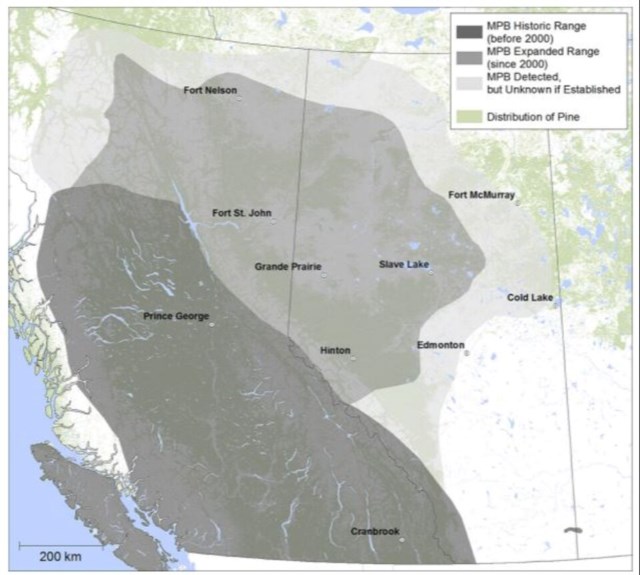

The researchers found the lower the humidity, the more the fungi grew and the more the beetles reproduced. High CO2 concentrations were also found to speed up the growth of larvae.
But when it came to ozone — another gas whose atmospheric concentration is expected to rise over the coming decades — increased concentrations were initially found to have a negative impact on mountain pine beetle reproduction and brood fitness. ?
?In the wild, a mountain pine beetle will attack a tree by making a hole in it. Once inside, it releases pheromones to attract other beetles, while releasing fungi that blocks a tree’s own toxic defences and inhibits arboreal mechanisms for transporting water and nutrients.
In the lab, the spike in ozone gas was originally found to degrade the pheromones beetles rely on for finding a mate. At first, it seemed the gas may have evened the odds and pushed back against the effects of CO2. But over the next three to four months, the following beetle generations started to adapt.
“When we tested the ozone, the first generation that came out, they were smaller and lower weight. By the third generation, they developed resistance,” said Zaman.
Expect more outbreaks
The results could have significant results for places like British Columbia, where mountain pine beetle infestations have already wiped out millions of hectares of forest in recent decades.
Zaman said climate modelling suggests more drought in B.C.’s future, something expected to weaken pine trees and make them more susceptible to infestation.
He said years of above-average wildfire may have helped halt the beetle’s advance, but over the long-term, Zaman and his colleagues forecast the mountain pine beetle will be able to adapt to a new forest regime and once again cause “significant ecological and economic consequences.”
“B.C. has been a hot spot for the pine beetle,” Zaman said. “We expect more outbreaks.”
If there’s any good news, the scientist said more studies still need to be done to confirm what they found.
Science
Record breaker! Milky Way's most monstrous stellar-mass black hole is sleeping giant lurking close to Earth (Video) – Space.com
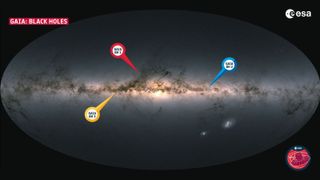

The Milky Way has a big newfound black hole, and it lurks close to Earth! This sleeping giant was discovered with the European space telescope Gaia, which tracks the motion of billions of stars in our galaxy.
Stellar-mass black holes are created when a large star runs out of fuel and collapses. The new discovery is a landmark, representing the first time that a big black hole with such an origin has been found close to Earth.
The stellar-mass black hole, designated Gaia-BH3, is 33 times more massive than our sun. The previous most massive black hole of this class found in the Milky Way was a black hole in an X-ray binary in the Cygnus constellation (Cyg X-1), whose mass is estimated to be around 20 times that of the sun. The average stellar-mass black hole in the Milky Way is about 10 times heftier than the sun.
Gaia-BH3 is located just 2,000 light years from Earth, making it the second-closest black hole to our planet ever discovered. The closest black hole to Earth is Gaia-BH1 (also discovered by Gaia), which is 1,560 light-years away. Gaia-BH1 has a mass around 9.6 times that of the sun, making it considerably smaller than this newly discovered black hole.
“Finding Gaia BH3 is like the moment in the film ‘The Matrix’ where Neo starts to ‘see’ the matrix,” George Seabrook, a scientist at Mullard Space Science Laboratory at University College London and a member of Gaia’s Black Hole Task Force, said in a statement sent to Space.com. “In our case, ‘the matrix’ is our galaxy’s population of dormant stellar black holes, which were hidden from us before Gaia detected them.”
Seabroke added that Gaia BH3 is an important clue to this population, because it is the most massive stellar black hole found in our galaxy.
Of course, Gaia-BH3 is a small fry compared to the supermassive black hole that dominates the heart of the Milky Way, Sagittarius A* (Sgr A*), which has a mass 4.2 million times that of the sun. Supermassive black holes like Sgr A* aren’t created by the deaths of massive stars but rather by mergers of progressively larger and larger black holes.
Sleeping giant black hole caused stellar companion to throw a wobbly
All black holes are marked by an outer boundary called an event horizon, at which point the black hole’s escape velocity exceeds the speed of light. That means an event horizon is a one-way light-trapping surface beyond which no information can escape.
As a result, black holes don’t emit or reflect light, meaning they can only be “seen” when they are surrounded by material that they gradually feed on. Sometimes, this means a black hole in a binary system pulling material from a companion star, which forms a disk of gas and dust around it.
The tremendous gravitational influence of black holes generates intense tidal forces in this surrounding matter, causing it to glow brightly with material that is destroyed and consumed, also emitting X-rays. Additionally, the material the black hole doesn’t feast on can be channeled to its poles and blasted out as near-light speed jets, which are accompanied by the emission of light.
All of these light emissions can allow astronomers to spot black holes. The question is, how can “dormant” black holes that aren’t feeding on gas and dust around them be detected? For instance, what if a stellar-mass black hole has a companion star, but the two are too widely separated for the black hole to snatch stellar matter from its binary partner?
In cases like this, the black hole and its companion star orbit a point that represents the system’s center of mass. This is also the case when a star is orbited by a light companion, such as another star or even a planet.
Orbiting the center of mass results in a wobble in the motion of the star, which is visible to astronomers. Because Gaia is adept at precisely measuring the motion of stars, it is the ideal instrument to see this wobble.
Gaia’s Black Hole Task Force set about looking for odd wobbles that couldn’t be accounted for by the presence of another star or a planet and that indicated a heavier companion, possibly a black hole.


Homing in on an old giant star in the constellation Aquila, located 1,926 light-years from Earth, the team found a wobble in the star’s path. That wobble suggests that the star is locked in orbital motion with a dormant black hole of exceptionally high mass. The two are separated by a distance that ranges from the distance between the sun and Neptune at their widest and our star and Jupiter at their closest.
“It’s a real unicorn,” lead researcher Pasquale Panuzzo of CNRS, Observatoire de Paris in France, said in a statement. “This is the kind of discovery you make once in your research life. So far, black holes this big have only ever been detected in distant galaxies by the LIGO-Virgo-KAGRA collaboration, thanks to observations of gravitational waves.”
Related: What are gravitational waves?


Thanks to the sensitivity of Gaia, the Black Hole Task Force was also able to put constraints on the mass of Gaia-BH3, finding it to possess 33 solar masses.
“Gaia-BH3 is the very first black hole for which we could measure the mass so accurately,” said Tsevi Mazeh, a scientist and Gaia collaboration member at Tel Aviv University. “At 30 times that of our sun, the object’s mass is typical of the estimates we have for the masses of the very distant black holes observed by gravitational wave experiments. Gaia’s measurements provide the first undisputable proof that [stellar-mass] black holes this heavy do exist.”
RELATED STORIES:
However, the Gaia-BH3 system is bound to be of great interest to scientists for more than just its proximity to Earth and the mass of its black hole.
The star in this system is a sub-giant star that is around five times as large as the sun with 15 times its brightness, though it is cooler and less dense than our star. The Gaia-BH3 companion star is mainly composed of hydrogen and helium, the universe’s two lightest elements, lacking heavier elements, which astronomers (somewhat confusingly) call “metals.”
The fact that this star is “metal-poor” suggests that the star that collapsed and died to create Gaia-BH3 also lacked heavier elements. Metal-poor stars are expected to shed more mass than their more metal-rich counterparts during their lives, so scientists have questioned if they can maintain enough mass to birth black holes. Gaia-BH3 represents the first hint that metal-poor stars can indeed do so.
“Gaia’s next data release is expected to contain many more, which should help us to ‘see’ more of ‘the matrix’ and to understand how dormant stellar black holes form,” Seabroke concluded.
The team’s research was published today (April 16) in the journal Astronomy & Astrophysics.
-
Business23 hours ago
Firefighters battle wildfire near Edson, Alta., after natural gas line rupture – CBC.ca
-



 Tech16 hours ago
Tech16 hours agoiPhone 15 Pro Desperado Mafia model launched at over ₹6.5 lakh- All details about this luxury iPhone from Caviar – HT Tech
-



 Sports16 hours ago
Sports16 hours agoLululemon unveils Canada's official Olympic kit for the Paris games – National Post
-



 Politics22 hours ago
Politics22 hours agoTrump gave MAGA politicians permission to move left on abortion. Some are taking it. – Semafor
-



 Politics23 hours ago
Politics23 hours agoAnti-Trump Republican Larry Hogan navigates dangerous political terrain in pivotal Senate contest – Toronto Star
-



 Science19 hours ago
Science19 hours agoAstronomers discover Milky Way's heaviest known black hole – Xinhua
-
Business21 hours ago
Traders Place Bets On $250 Oil – OilPrice.com
-
News23 hours ago
'Terrific news': Chief economist reacts to latest inflation data – BNN Bloomberg


